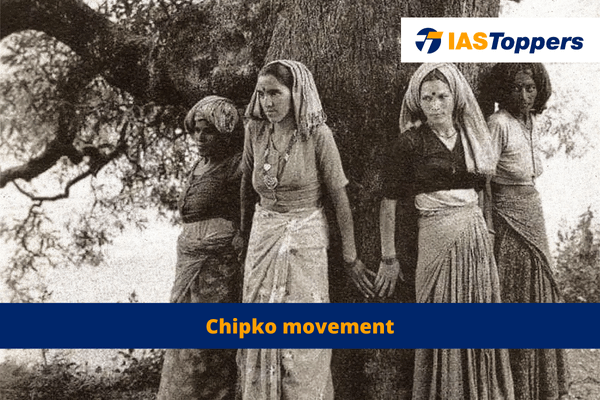Chipko movement is a series of movement that started in18th century in Rajasthan. Chipko movement is related to the conservation of trees and forests. In this article, you will learn about Chipko movement, origin, story, impact of Chipko movement, providing key insights for GS Paper-III Environmnt and ecology section of UPSC IAS Exam.
Table of Content
- What is Chipko movement?
- Origin of Chipko Movement in India
- Modern Chipko movement
- Causes of Chipko movement in Chamoli
- Chipko Andolan in Chamoli
- Sunderlal Bahuguna and the Chipko Andolan
- Conclusion
- Frequently Asked Questions
- Reference
What is Chipko movement?
- The Chipko movement was a series of peaceful protest that started in the 18th century aiming to safeguard trees and forests.
- The Chipko movement is also known as Chipko Andolan.
- The Chipko movement was initiated by the Bishnoi community in Rajasthan.
- The term “Chipko” means “embrace,” which symbolised the villagers’ act of hugging and encircling trees to prevent them from being cut down.
- The Chipko aandolan involved collective mobilization of women to safeguard trees.
Origin of Chipko Movement in India:
- Amrita Devi was the leader of Chipko movement.
- Many villagers had sacrificed their lives in order to protect the Khejri trees from being cut down on the orders of the Jodhpur King.
- As a result, the king issued a royal decree that prohibited the tree felling in all Bishnoi villages.
Modern Chipko movement:
- The modern Chipko Andolan occurred in 1973 in Chamoli district of Uttar Pradesh (now Uttarakhand).
- This later on got spread into other northern states of India.
- The modern Chipko Andolan was sparked by the rapid development in Uttar Pradesh after the 1963 border conflict with China.
- This development attracted foreign companies who were eager to exploit the state’s abundant forest resources.
- The Indian Forest Acts of 1878 and 1927 has allowed the government to manage natural resources of forests.
- These laws gave the state the right to exclusively control the use of certain areas.
- This had a negative impact on communities that had traditionally relied on forests for their survival.
Causes of Chipko movement in Chamoli:
- The forests were essential to the villagers’ survival as forests provided them food and fuel.
- In 1970, floods have destroyed many regions of vegetation, this also aggravated the situation.
- The government’s policy has also prohibited local farmers and herders from cutting down trees for fuelwood and fodder, causing more frustration amongst the villagers.
- The final provocation came when permission was granted to a sports manufacturing company to fell trees for equipment production.
Chipko Andolan in Chamoli:
- In 1973, the Chipko Andolan was led by environmentalist and Gandhian social activist Chandi Prasad Bhatt near the village of Mandal.
- Chandi Prasad Bhatt was the founder of the cooperative organization Dasholi Gram Swarajya Sangh.
- After their appeals were rejected, Bhatt and a group of villagers went into the forest and embraced the trees to stop the logging activities.
- After many days of persistent protest, the government ultimately cancelled the logging permit of the company.
- Gaura Devi was another leader of Chipko Andolan who led the movement in Reni village of Uttarakhand.
- The Chipko Andolan is considered as a women’s movement as women who looks after agriculture, livestock, and children were the worst sufferer due to floods, urbanization and landslides induced deforestation.
- The movement’s message was directly related to women as it highlighted the connection between their hardships and the destruction of forests for commercial interests.
- Thus, the Chipko Andolan holds a significant place as an eco-feminist movement.
Sunderlal Bahuguna and the Chipko Andolan:
- Sunderlal Bahuguna was an environmental activist who played a key role in advancing the Chipko Movement.
- Sunderlal Bahuguna devoted his life to persuade and educate villagers about the importance of forest and Himalayan conservation.
- Bahuguna’s efforts led Prime Minister Indira Gandhi to impose a ban on tree cutting.
- Sunderlal Bahuguna’sslogan, “ecology is the permanent economy,” remains a testament to his enduring legacy.
- Sunderlal Bahuguna is also known as father of Chipko movement.
Conclusion
The Chipko Andolan of Bishnoi community continues to inspire many ecological movements even today. The importance of Chipko movement was such that it has also inspired Appiko movement in Karnataka. The role of women in Chipko movement has led to boost in eco-feminist movement. Nowadays, the Chipko movement is associated with not just trees or ecology anymore but with the pride of women that are the part of forest communities
Ref:Source-1
| Other Articles in Environment & Disaster Management | |
| Deforestation | Environmental Impact Assessment (EIA) |
| Compensatory Afforestation | Eco Sensitive Zone (ESZ) in India |
| Green GDP | National Green Tribunal |
FAQs (Frequently Asked Questions)
What do you mean by Chipko movement?
The Chipko movement was a peaceful protest that started in the 18th century aiming to safeguard trees and forests.
Who started Chipko movement?
The Chipko movement was started by Amrita Devi.
Chipko movement was originated in ________ district in Uttarakhand
The Chipko movement originated in Chamoli district in Uttarakhand.
What was the aim of Chipko movement? Or Why did the Chipko movement take place?
Chipko movement was started to conserve the trees and forests.
Who is the founder of Chipko movement?
Sunderlal Bahuguna is said to be the founder of Chipko movement.
Which state started Chipko andolan? Or Where was Chipko movement started?
The Chipko movement was started in Rajasthan.
When did Chipko movement started?
The modern Chipko movement was started in 1973.



